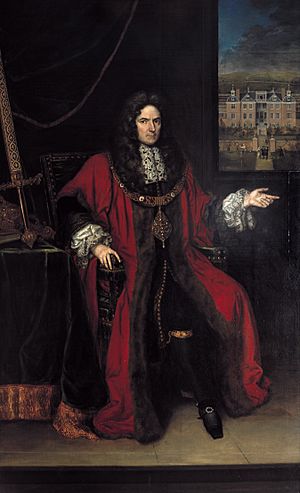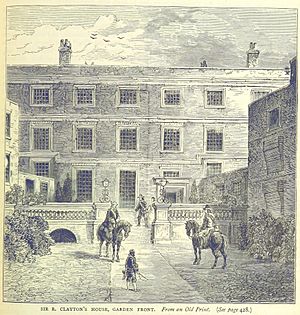Robert Clayton (City of London MP) facts for kids
Quick facts for kids
The Rt. Hon.
Sir Robert Clayton
|
|
|---|---|

Robert Clayton by Laureys a Castro
|
|
| Lord Mayor of London | |
| In office 1679–1680 |
|
| Preceded by | James Edwards (Lord Mayor) |
| Succeeded by | Patience Ward |
| Personal details | |
| Born | 1629 Northamptonshire |
| Died | 1707 (aged 77–78) |
| Nationality | British |
| Occupation | Banker, politician |
Sir Robert Clayton (1629–1707) was an important British banker and politician. He also served as the Lord Mayor of London, a very important role in the city.
Contents
Sir Robert Clayton's Life
Robert Clayton was born in Northamptonshire, England, in 1629. He moved to London to become an apprentice to his uncle. His uncle was a "scrivener," which was like a lawyer who prepared legal documents.
While learning, Robert met another apprentice named John Morris. They became very successful business partners. Together, they started their own bank called Clayton & Morris Co.
Entering Politics
Robert Clayton became involved in politics. He was elected to represent London and Bletchingley in the English Parliament. He was a member of the Whig political group. He served in Parliament from 1679 until he died in 1707.
In 1671, he was made a "knight," which gave him the title "Sir." Robert Clayton earned a lot of money during his life. In 1697, he even lent King William III £30,000 to help pay for the army. This was a huge amount of money back then.
In the mid-1650s, Robert Clayton bought Brownsea Island and its castle. This island is located off the coast of Dorset, England.
Helping the Community
Sir Robert Clayton was the president of St Thomas' Hospital in London. This hospital was located in the area known as the Borough. He hired an architect named Thomas Cartwright to rebuild the hospital. He also had St Thomas Church rebuilt nearby.
Clayton was a member of several important groups in London. These included the Scriveners and Drapers Company. He held many important jobs, such as:
- An Alderman for Cheap Ward in the City of London (1670–1683)
- A Sheriff in 1671
- Lord Mayor of London (1679–1680)
- A Colonel in the Orange Regiment, London Trained Bands (a local military group)
- President of the Honourable Artillery Company
- A director of the Bank of England (1702–1707)
In the 1690s, Sir Robert Clayton was also a leader in one of the earliest Freemason groups in London. This group was made up of people who were not working masons.
Royal African Company Involvement
Sir Robert Clayton was a member of the Court of Assistants for the Royal African Company. This meant he was on the board of directors for the company. The Royal African Company was involved in the Atlantic slave trade. It transported a very large number of enslaved people from Africa to the Americas.
Clayton married Martha Trott. Her father was a merchant from Bermuda. He also worked as a "Factor" in Bermuda, which means he acted as a business agent there.
Sir Robert Clayton's Legacy
Sir Robert and Lady Clayton are buried in St Mary's church in Bletchingley.
A statue of Clayton once stood at St Thomas' Hospital. It was located at the North Entrance to the Ward Block of the North Wing. This statue is listed as a Grade I historical building.
On June 11, 2020, the Guy's and St Thomas' NHS Foundation Trust made an announcement. They decided to remove Clayton's statue from public view. A statue of Thomas Guy was also removed at the same time.


